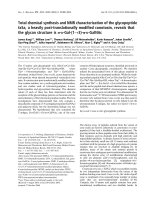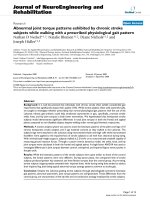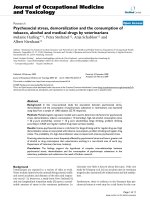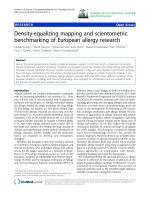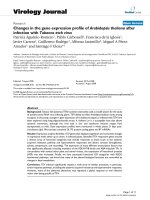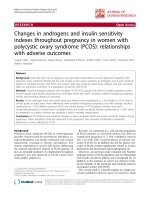Báo cáo hóa học: " Wet chemical synthesis and magnetic properties of single crystal Co nanochains with surface amorphous passivation Co layers" pdf
Bạn đang xem bản rút gọn của tài liệu. Xem và tải ngay bản đầy đủ của tài liệu tại đây (697.21 KB, 5 trang )
NANO EXPRESS Open Access
Wet chemical synthesis and magnetic properties
of single crystal Co nanochains with surface
amorphous passivation Co layers
Shao-Min Zhou
*
, Shi-Yun Lou, Yong-Qiang Wang, Xi-Liang Chen, Li-Sheng Liu and Hong-Lei Yuan
Abstract: In this study, for the first time, high-yield chain-like one-dimensional (1D) Co nanostructures without any
impurity have been produced by means of a solution dispersion approach under permanent-magnet. Size,
morphology, component, and structure of the as-made samples have been confirmed by several techniques, and
nanochains (NCs) with diameter of approximately 60 nm consisting of single-crystalline Co and amorphous
Co-capped layer (about 3 nm) have been materialized. The as-synthesized Co samples do not include any other
adulterants. The high-quality NC growth mechanism is proposed to be driven by magnetostatic interaction
because NC can be reorganized under a weak magnetic field. Room-temperature-enhanced coercivity of NCs was
observed, which is considered to have potential applications in spin filtering, high density magnetic recording, and
nanosensors.
PACS: 61.46.Df; 75.50; 81.0 7.Vb; 81.07.
Introduction
In the last de cade, diverse technological applications of
magnetic nanostructures in magnetofluid, recording
tape, flexible disk recor ding media, permanent magnets,
microwave oscillators as well as biomedical materials,
and catalysts have provided an impetus for extensive
research in nanometer scale magnets [1-17]. Most of
these applications rely on the stability of ferromagnetic
ordering with temperature. In nanometer scale magnets,
the thermal fluctuations randomize the magnetic
moment by overcoming the anisotropy energy leading
to unstable state of paramagnetism (non-magnetic mate-
rials) or superparamagnetism (corresponding coercivity
and hysteresis fall to zero). Cobalt (Co) is superior to
other ferromagnetic materials because of its highest
Curie temperature (T
c
) of about 1394 K, which is crucial
for thermal stability in high-temperature nanodevice
applications [1,5-16]. For realizing high T
c
,magnetiza-
tion, and coercivity, the aim must be directed toward
increasing the amount of the ferromagnetic Co phase
[7-10]. Owing to its basic me tallic characteristic, pure
cobalt, especially for nanosized Co, is very reactive and
must be unstabilized in ambient air [11], and therefore,
its use has been limited to prepare Co nanostructures in
the absence of the shell [11-16]. A very simple bottom-
up method is to produce stab le film-assisted synthesis
for a surface w ith slightly controlled Co to passivate
the surface of the host materials, including organic
and inorganic templates, and alloyed technique
[1,2,5-10,12-16]. For example, recently, control of mag-
netism in cobalt nanoparticles by o xygen passivation
was reported by Srikala’ s research group [14,15], and
cobalt nanowires with controlled diameters have been
synthesized using electro chemical deposition in etched-
ion-track polycarbonate membranes [16]. In this latter
case, however, corresponding magnetic properties are
inevitably decreased by the addition of non-magnetic
materials or natural oxide layers [1,5-16]. As far as we
know, amorphous phases lack long-range crystalline
order and have unique electronic, magnetic and corro-
sion-resistant properties. In this article, based on our
earlier study [17], we report for the first time a wet che-
mical synthesis of high-pure Co nanoc hains (NCs) with-
out any oxide shells and templates. The amorphous Co
covering layer would be able to protect the active Co
core from oxygen in atmosphere. In particular, the
room-temperature coercivity (up to 355.8 Oe) of the
NCs i s larger than that (93.6 Oe) of pure single-crystal
* Correspondence:
Key Lab for Special Functional Materials of Ministry of Education, Henan
University, 475004 Kaifeng, People’s Republic of China
Zhou et al. Nanoscale Research Letters 2011, 6:285
/>© 2011 Zhou et al; licensee Springer. This is an Open Access article distributed under the terms of the Creative Commons Attribution
License ( which permits unrestricted use, distribution, and reproduction in any medium,
provided the original work is properly cited .
Co (PSC) metal, which will make them as promising
candidates for advanced magnetic media and investiga-
tive studies on novel great magnetoresistive properties.
Experimental section
In a typical experiment, 10.0 mL glycerine was heated to
the boiling point (approx 560 K) and refluxed for 3 min.
Then, 50 mL of hydrazine monohydrate was added drop-
wise to the boiling solution. Aft er 1 min, 10.0 mL of Co
(NO
3
)
2
6H
2
O solution (0.5 mol/L, in glycerine) and
10.0 mL of hydrazine hydrate solut ion (0.5 mol/L, in gly-
cerine) were added rapidl y to the boiling solution under
vigorous magnetic stirring. After refluxing for approx 80
min, as proposed in our previous article [17], the final
products in the form of loose powders (large quantities
of light-gray wool-like products ) were obtained by centri-
fugation under permanent-magnet (approx. 0.5 T). The
powders were rinsed repeatedly with absolute ethanol for
several times, followed by the removal of the residual sol-
vent through evaporation in vacuum at 500 K. The yield
of the as-prepared Co specimens is about 60% according
to our calculation. We noticed that no sign of o xidation
was observed on the as-synthesized metal Co NCs even
after aging for over 1 month under ambient conditions.
This indicates that the Co NCs areverystableaftersur-
face modification with amorphous Co, which is very
important for future applications. The samples were
characterized extensively for morphology, phase, and
chemical composition using scanning/transmission elec-
tron microscopy (SEM/TEM), energy dispersive X-ray
spectroscopy (EDS), X-ray powder diffraction (XRD),
selective area electron diffraction (SAED), high resolution
TEM (HRTEM), and X-ray photoelectron spectroscopy
(XPS). The temperature dependence of magnetization
and room temperature (RT) hysteresis curves were car-
ried out by means of vibrating sample magnetometer
(VSM, Model 4 HF) and physical properties measure-
ment system (PPMS, Quantum Design PPMS-7).
Results and discussion
Figure 1a shows a typical SEM ima ge, in which high
dense (high-yield) chain-like nanostructures are observed.
One can observe that the diameter and length of single
NCs are approx. 60 nm and several micrometers, respec-
tively. A high-resolution SEM image is demonstrated in
the inset of Figure 1a where a nanoparticle ar ray, ta ken
from a single NC, is clearly seen. Based on SEM statistic
analysis, the yield of the NCs is for approx. 60%. The
XRD patterns of bulk Co NCs (Figure 1b) reveal that the
two sharp diffraction peaks can be assigned to the Co
face-centered cubic (FCC/Fm3m)structure(a = 0.354
nm) (see Card No. 15-0806, JCPDS-ICDD, June 2002).
Two very broad peaks are noticed in 2 theta angles (20-
40 and 45-60), which may resul t from the amorphous
passivation Co layers and substrate. In addition, no
impurity phases such as cobalt oxides or precursor com-
pounds have been confirmed within instrumental error.
More accurately, XPS was used to determine the compo-
sition of the bulk Co-NC samples. As shown Figure 1c, a
range of XPS spectrum is indicated, in which the inten-
sive peaks located at 778. 3 eV (Co2p3/2) and 793.3 eV
(Co2p1/2) correspond to the respective electronic states
of metallic Co. As indicated with the arrows, these wide
10 20 30 40 50 60 70 80
b
(200)
(111)
Intensity (a.u.)
2 Theta/deg
1400 1200 1000 800 600 400 200
0
c
from Al Auger signals
Co 3p
Co 3s
Co 2p3/2
Co 2p1/2
Co 2s
Intensity (a.u)
BE (eV)
Figure 1 A typical (a) SEM image (inset: HRSEM), (b) XRD and
(c) XPS patterns of the collected Co-NCs.
Zhou et al. Nanoscale Research Letters 2011, 6:285
/>Page 2 of 5
peaks (from 831 to 838 and from 777 to 698) originate
from auger lines of monochromated Al for XPS charac-
terization. It is clear that the NCs are high-pure Co
0
with
other elements absent, which is in very good agreement
with the results of XRD. As shown in Figure 2a, a typical
slight enlargement TEM image of the as-synthesized
large-scale NCs is exhibited. From the TEM image, one
can, by closer observation, conclude that perfectly aligned
nanoparticles (chain-like nanostructures) were produced
and the diameter of individual Co NCs is approx. 60 nm.
For microanalysis, HRTEM, SAED, and EDS were
employed for phase, and composition of single NCs. A
HRTEM image taken from a single nanoparticle is shown
in Figure 2b, in which the presence of the gray edge
without any stripes and the center with perfect continu-
ous lattice fringes reveals the amorphous passivation shell
(marked with the large white arrow) and high-quality
crystal core growth. The l attice spacing of 8.86 Å (5 ×
1.772 Å) is consistent with that of the [200] planes of sin-
gle-crystalline face-centered Co, which is compatible with
the data of X RD. The SAED patterns (see the inset in
Figure 2b) are compo sed of the regular, clear diffraction
dots, which reveal the single crystalline nature and can
be indexed to the FCC Co. Diffraction patterns taken
from different parts along the NC axis show the same
features, indicating the same periodical orientation along
the single-crystalline Co NC. Based on micro-composi-
tion-analysis, Figure 3a gives a typical EDS pattern, in
which only the Co peaks can be indexed within experi-
mental error, and the peaks of e lements Cu and C are
attributable to copper grid with carbon film.
The synthesized NCs can be reorganized in a weak
magnetic field. Typically, the purified Co NCs were dis-
persed into de-ionized water by ultrasonic agitation.
A drop of the Co NCs solution was dripped on a copper
grid with holes and carbon film to characterize the TEM
in the absence or the presence of the weak external
magneticfield(about0.5T)anddriednaturally.The
result reveals that the NCs in the weak magnetic field
have aligned according to the direction of the magnetic
field as shown in Figure 3b, whereas without the exter-
nal magnetic field, nonaligned NCs appear as shown in
Figure 3c. Regarding the mechanism for the growth of
the highly branched Co nanoparticle chains, we believe
that magnetostatic interaction plays an important role.
The magnetic dipole-dipole interaction displayed beha-
vior similar to that of soft templates. Initially, very small
Co nanoparticles were formed. With the increase of the
growth time, presumably, the sm all Co nanopart icles
diffused and aggregated to form larger nanoparticles.
The Co nanoparticles were then assembled into neck-
like chains with multiple branches because of the stron-
ger anisotropic magnetic forces, and these findings are
in agreement with those of our earlier article [17].
Despite the presence of the amorphous buffer layer, the
NCs display a strong ferromagnetic behavior. Figure 4a
shows the magnet ization curve as a function of tempera-
ture for the NCs a nd PSC metal. As can be se en, for the
NCs, a sharp magnetic transition is observed for T =
~600 K as determined from the inflection point of the
magnetization versus temperature curve; the inflection
point may result from the enhanced single-crystal Co
mass from amorphous Co because the corresponding
magnetic transition disappears in PSC under the same
conditions. Figure 4b shows the magnetic hysteresis loop,
measured at RT with the applied magnetic field perpen-
dicular to the substrate surfa ce. Based on both these
curves, coercive fields (H
c
) of 355.8 and 93.6 Oe, respec-
tively, for NCs and PSC, saturation magnetizations (M
s
)
of 125.7 and 162.5 emu/g, respectively, for NCs and PSC,
and remnant magnetization (M
r
) up to 46.6, and 4.5
emu/g, respectively, for NCs and PSC were determined.
A detailed analysis of the magnetic properties as a func-
tion of the NC wit h various amorphous shell sizes will be
published separately.
Figure 2 A typical (a) TEM and (b) HRTEM image of Co-NCs
(inset: SAED pattern).
Zhou et al. Nanoscale Research Letters 2011, 6:285
/>Page 3 of 5
Conclusion
In this study, this proposed method provides a simple and
inexpensive method for the preparation of stable, magnetic
Co NCs with the complete absence of impurities. The as-
synthesized NCs are produced with increasing H
c
and M
r
at room temperature. In addition, the large H
c
,coupled
with the controllable coercive field, makes these NC arrays
the preferable candidates for probe-based data-storage sys-
tems. Introducing long-range, 1D translational order over
macroscopic distances among the NCs will undoubtedly
be a key driver in this respect, and is an area that clearly
warrants future exploration.
Abbreviations
EDS: energy dispersive X-ray spectroscopy; HRTEM: high-re solution TEM; NCs:
nanochains; PSC: pure single-crystal Co; SAED: selective area electron
diffraction; SEM: scanning electron microscopy; transmission electron
microscopy (TEM); XPS: X-ray photoelectron spectroscopy; XRD: X-ray
powder diffraction; RT: room-temperature; VSM: vibrating sample
magnetometer; PPMS: physical properties measurement system.
Acknowledgements
This study was partially supported by the Program for Science & Technology
Innovation Talents in Universities of Henan Province (No. 2008 HASTIT002),
Innovation Scientists and Technicians Troop Construction Projects of Henan
Province (No. 094100510015), and by the Natural Science Foundation of
China under Grant No. 20971036.
Open Access: This article is distributed under the terms of the Creative
Commons Attribution Noncommercial License which permits any
noncommercial use, distribution, and reproduction in any medium, provided
the original author(s) and source are credited.
Authors’ contributions
SM: carried out the experimental and numerical calculations, as well as
drafted the manuscript. VSM and PPMS: performed an analysis and
interpretation of results, and gave final approval of the version to be
-6000 -4000 -2000 0 2000 4000 6000
-200
-150
-100
-50
0
50
100
150
200
b
Ms, Mr, Hc
162.50, 4.5, 93.6(PSC)
125.7, 46.6, 355.8(NCs)
M(emu/g)
H
(
Oe
)
100 200 300 400 500 600 700 80
0
1.560
1.565
1.570
1.575
1.580
1.585
1.590
a
PSC
NC
M (emu)
T (K)
Figure 4 (a) Magnetization versus temperature for Co NCs
(red) and PSC (black) and (b) RT magnetic hysteresis curves of
the Co NCs (red) and PSC (black).
051015
a
Co
C
Cu
Cu
Cu
Co
Co
Intensity (a.u.)
Energy (KeV)
Figure 3 (a) EDS pattern of the as-synthesized NCs, and both
TEM images of the (b) nonaligned and (c) aligned nanoparticles,
respectively, obtained from without external magnetic field and
with weak external magnetic field (approx. 0.5 T).
Zhou et al. Nanoscale Research Letters 2011, 6:285
/>Page 4 of 5
published. SY and YQ: partly carried out the TEM and HRTEM experiments,
as well as drafted the manuscript. XL, LS, and HL: conceived of the study,
and participated in its design and coordination. All authors read and
approved the final manuscript.
Competing interests
The authors declare that they have no competing interests.
Received: 1 February 2011 Accepted: 4 April 2011
Published: 4 April 2011
References
1. Whitney T, Searson P, Jiang J, Chien C: Fabrication and magnetic-
properties of arrays of metallic nanowires. Science 1993, 261:1316.
2. Li P, Wang R, Chen W, Chen C, Gao X, Wee A: Well-aligned nickel
nanochains synthesized by a template-free route. Nanoscale Res Lett
2009, 4:480.
3. Zhou S, Liu L, Yuan H, Chen X, Lou S, Hao Y, Yuan R, Li N: Magnetic
properties of Ni-doped ZnO nanocombs by CVD approach. Nanoscale Res
Lett 2010, 5:1284.
4. Yuan H, Wang Y, Zhou S, Liu L, Chen X, Lou S, Yuan R, Hao Y, Li N: Low-
temperature preparation of superparamagnetic CoFe2O4 microspheres
with high saturation magnetization. Nanoscale Res Lett 2010, 5:1718.
5. Cao H, Xu Z, Sang H, Sheng D, Tie C: Template synthesis and magnetic
behavior of an array of cobalt nanowires encapsulated in polyaniline
nanotubules. Adv Mater 2001, 13:121.
6. Knez M, Bittner A, Boes F, Wege C, Jeske H, Maiss E, Kern K: Biotemplate
synthesis of 3 nm nickel and cobalt nanowires. Nano Lett 2003, 3:1079.
7. Rohart S, Raufast C, Favre L, Bernstein E, Bonet E, Dupuis V: Magnetic
anisotropy of CoxPt1-x clusters embedded in a matrix: Influences of the
cluster chemical composition and the matrix nature. Phys Rev B 2006,
74:104408.
8. Zhang L, Lan T, Wang J, Wei L, Yang Z, Zhang Y: Template-free synthesis
of one-dimensional cobalt nanostructures by hydrazine reduction route.
Nanoscale Res Lett 2011, 6:68.
9. Wang G, Zhang F, Zuo H, Yu Z, Ge S: Fabrication and magnetic Properties
of Fe65Co35-ZnO nano-granular films. Nanoscale Res Lett 2010, 5:1107.
10. Brands M, Hassel C, Carl A: Electron-electron interaction in quasi-one-
dimensional cobalt nanowires capped with platinum: Low-temperature
magnetoresistance measurements. Phys Rev B 2006, 74:033406.
11. Li X, Xu C, Han X, Qiao L, Wang T, Li F: Synthesis and Magnetic Properties
of nearly monodisperse CoFe2O4 nanoparticles through a simple
hydrothermal condition. Nanoscale Res Lett 2010, 5:1039.
12. Narayanan T, Shaijumon M, Ajayan P, Anantharaman M: Synthesis of high
coercivity core-shell nanorods based on nickel and cobalt and their
magnetic properties. Nanoscale Res Lett 2010, 5:164.
13. Gangopadhyay S, Hadjipanayis G, Dale B, Sorensen C, Klabunde K,
Papaefthymiou V, Kostikas A: Magnetic properties of ultrafine iron
particles. Phys Rev B 1992, 45:9778.
14. Srikala D, Singh V, Banerjee A, Mehta B, Patnaik S: Control of magnetism in
cobalt nanoparticles by oxygen passivation. J Phys Chem C 2008,
112
:13882.
15. Srikala D, Singh V, Banerjee A, Mehta B, Patnaik S: Synthesis and
characterization of ferromagnetic cobalt nanospheres, nanodiscs and
nanocubes. J Nanosci Nanotechnol 2009, 9:5627.
16. Maaz K, Karim S, Usman M, Mumtaz A, Liu J, Duan J, Maqbool M: Effect of
crystallographic texture on magnetic characteristics of cobalt nanowires.
Nanoscale Res Lett 2010, 5:1111.
17. Zhou S, Zhang X, Gong H, Zhang B, Wu Z, Du Z, Wu S: Magnetic
enhancement of pure gamma Fe2O3 nanochains by chemical vapor
deposition. J Phys Condens Matter 2008, 20:075217.
doi:10.1186/1556-276X-6-285
Cite this article as: Zhou et al .: Wet chemical synthesis and magnetic
properties of single crystal Co nanochains with surface amorphous
passivation Co layers. Nanoscale Research Letters 2011 6:285.
Submit your manuscript to a
journal and benefi t from:
7 Convenient online submission
7 Rigorous peer review
7 Immediate publication on acceptance
7 Open access: articles freely available online
7 High visibility within the fi eld
7 Retaining the copyright to your article
Submit your next manuscript at 7 springeropen.com
Zhou et al. Nanoscale Research Letters 2011, 6:285
/>Page 5 of 5
